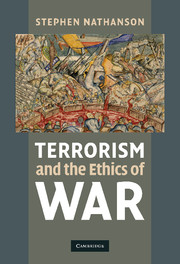Book contents
- Frontmatter
- Contents
- Acknowledgments
- Introduction
- PART I TERRORISM: WHAT'S IN A NAME?
- 1 The problem of defining terrorism
- 2 Defining terrorism
- 3 What makes terrorism wrong?
- 4 Innocence and discrimination
- 5 “Who dun it” definitions of terrorism
- Conclusion: taking stock
- PART II WHY MORAL CONDEMNATIONS OF TERRORISM LACK CREDIBILITY
- PART III DEFENDING NONCOMBATANT IMMUNITY
- PART IV HOW MUCH IMMUNITY SHOULD NONCOMBATANTS HAVE?
- Conclusion: terrorism and the ethics of war
- Bibliography
- Index
4 - Innocence and discrimination
Published online by Cambridge University Press: 05 June 2012
- Frontmatter
- Contents
- Acknowledgments
- Introduction
- PART I TERRORISM: WHAT'S IN A NAME?
- 1 The problem of defining terrorism
- 2 Defining terrorism
- 3 What makes terrorism wrong?
- 4 Innocence and discrimination
- 5 “Who dun it” definitions of terrorism
- Conclusion: taking stock
- PART II WHY MORAL CONDEMNATIONS OF TERRORISM LACK CREDIBILITY
- PART III DEFENDING NONCOMBATANT IMMUNITY
- PART IV HOW MUCH IMMUNITY SHOULD NONCOMBATANTS HAVE?
- Conclusion: terrorism and the ethics of war
- Bibliography
- Index
Summary
Terrorist acts, I have argued, have the following feature: they intentionally kill or injure innocent people or pose a serious threat of such harms to innocent people. One aspect of this feature, indicated by the word “intentionally,” involves the manner in which the killing or injuring occurs. The harms that terrorist acts produce are not side effects; they are exactly what the attackers aim to produce. A second aspect, indicated by the word “innocent,” identifies a feature of terrorism's victims. The victims are not targeted for reasons that relate specifically to them as individuals. Sometimes this feature is suggested by use of the word “random,” as in Michael Walzer's description of terrorism as “the random murder of innocent people.” While “random” is not quite the right word, Walzer is right to suggest a certain indiscriminateness in the relationship between the attack and the individual victims. Which specific individuals suffer is random even if other things about them are not.
Both of these ideas are open to criticism. Some critics want to delete the word “intentional” from the definition so that “terrorism” can apply to attacks that cause collateral damage to innocent people. A second criticism is that the word “innocent,” which plays a central role in the definition, is neither clear nor morally neutral. If it is not clarified, the definition is useless; if it is clarified, it will cease to be morally neutral.
- Type
- Chapter
- Information
- Terrorism and the Ethics of War , pp. 40 - 58Publisher: Cambridge University PressPrint publication year: 2010



